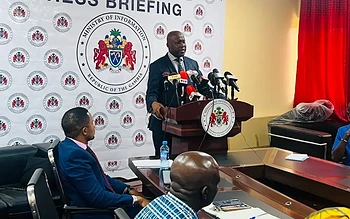![]()
By Talibeh Hydara
On Saturday 21 December 2024, the Banjul International Airport was hit by a power outage which led to two international flights diverting to neighboring Senegal.
Both Asky and SN Brussels flights reportedly made several attempts at landing and aborted because of the blackout.
Though the GCAA blamed Nawec for the power outage, the state energy company issued a statement saying they have given an advanced notice to all institutions about their scheduled maintenance works.
The incident attracted public outrage that The Gambia’s only airport neither has an independent power supply system nor a reliable backup in case the utility provider Nawec fails to stabilize electricity.
That is unfortunately not new. A special audit on the Airport Improvement Project Phase II—finalised in December 2021 by National Audit Office—has found that the GCAA does not have a sufficient back-up generator when NAWEC is out.
The Airport has procured two generators as part of the improvement works carried out between 2014 to 2020. At least two staff familiar with activities at the Airport told The Republic that the two back-up generators were meant to alternate in case of power outage from the national utility provider.
But increased energy needs created by the renovations forced the Authority to synchronize the two to run as one unit, leaving the airport without a sufficient back-up generator for 24 hrs reliable energy supply.
“During our visit to the generator house, we noted that two generators of 650 KVA each were installed. According to the project engineer, to have a proper cooling system at the airport main waiting hall, the two generators should operate simultaneously. This implies that there will be no standby generator to provide electricity in the event of power failure,” said the auditors.
After this issue was raised by auditors in December 2021, the Authority promised to do something about it.
“The issue of the powerhouse is of great concern to the PMU (Project Management Unit) and the Authority as a whole,” said the management in response to auditors. “The current situation is reported to the GCAA management for redress.”
The cooling problems persisted to a tragic end when a checked-in British passenger passed away on the floor of the airport in October 2023.
The Republic could not verify whether a new generator with a bigger capacity was procured as recommended by the auditors. The managing director of GCAA, Nfansu Bojang, neither picked our call nor replied to our message.
Information Minister Dr Ismaila Ceesay told Coffee Time that the government will do a comprehensive review of the incident to establish what went wrong, whether there was negligence or human error.
The auditors also reported theft incidents of items procured by the project, including the disappearance of at least 48 light bulbs from the control tower and 3 covers of lighting-fixtures.
The existing Liquefied Petroleum Gas (LPG) network was also stolen from the main supply line. The GCAA acknowledged these cases but told auditors the contractor is responsible for loss of items on site.
Female ATC’s near-death experience
Flight diversions can cause a huge scare among passengers but an even bigger scare was caused in The Gambia’s first and only female Air Traffic Controller. She got stuck in the elevator of the Airport’s 7-floor tower for an hour and by the time the doors were opened, she was already unconscious due to insufficient oxygen supply.
The Republic has been informed that it took longer than usual to get her to the hospital because the airport ambulance does not have a siren to maneuver through traffic or proper first aid equipment. It is at least five years old and requires serious maintenance.
Interestingly, the GCAA signed an agreement two days later to acquire a new ambulance for the airport. The Republic understands that discussions with the Gambia Red Cross Society for the new ambulance dragged on for a year until the unfortunate event.
Fat allowances
The Gambia government secured $34.8m from Kuwait, Saudi and OPEC to carry out improvement works at the Airport from 2014 to 2020. Though this project could not build an independent power source for the Airport, it was enough to pay thousands of dollars monthly allowances to the GCAA staff.
The payments range from $500, $400, $350 to $150 monthly to several senior management and project staff. “… Basis and justification for payment of such allowances was not provided after several requests were made,” said the auditors.
The GCAA claimed the funding agencies have agreed to payments made to its project staff though the Authority has failed to provide any proof of it.
We could not determine the number of staff who received the payment and how much each person received during the course of the project.
Suspicious payments
The contract of the Airport improvement project has had two modifications— addition to the contract— often called an addendum. This usually happens where issues arise that are not factored in the initial contract.
During the course of the improvement works, at least 6 items that were supposed to have been done and already paid for in the initial contract were put in the two subsequent addenda.
The GCAA management claimed this was done because “items were listed in previous addendum but not executed and are repeated until they are done”.
“But an unexecuted work does not require an addendum,” said a government procurement specialist who prefers anonymity. “You only have to remind the contractors of it.”
Though we could not quantify the cost of the work duplicated. The duplicated items include significant works such as replacing the conveyor belt in the arrival hall (which was not compatible with the scanning machine), refurbishing the control tower with new equipment, floor tiles for first and ground floor terminal buildings and new ceiling including lighting.
Meanwhile, the auditors have also highlighted a reported overpayment of the project consultant by $1.6m. The Airport attributed the increment in payment to further works funded by the Saudi Fund that were not part of the initial plans.
The adverse findings of the GCAA audit raising many issues were shared with its line ministry, The Ministry of Works, but no investigation has been launched.
The audit exercise was supposed to be a joint work between the Ministry of Works and the NAO. The ministry was supposed to do the technical assessment of the finished work. A source informed The Republic that the ministry never participated for reasons they have never explained.
Strikingly, even though the audit report was finalized two years ago, it still remains unpublished.
Be our accomplice! We rely on donor funding and donation from individuals to support our investigations. Click donate to support our work!


